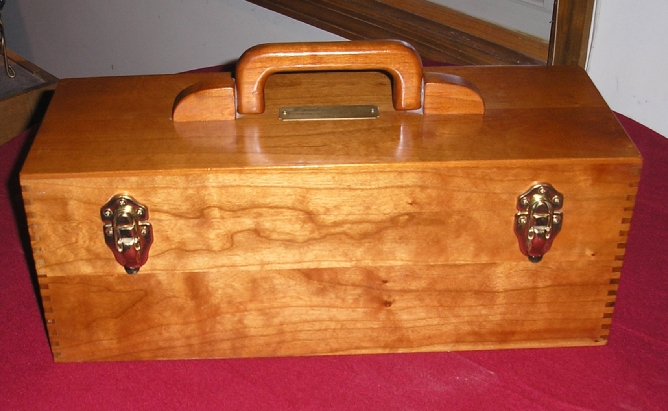Posts: 22,222
Threads: 0
Joined: Nov 2002
11-18-2018, 09:20 PM
(This post was last modified: 11-18-2018, 09:21 PM by Edwin Hackleman.)
In the past have made quite a few boxes using various hardwoods and even southern yellow pine. Most have been made with stock that is less than 1/2" thick.
I recently acquired a collection of quartersawn white oak, dry as a bone and 1-1/8" thick, random widths from 4" to 8" wide. I have never used quartersawn white oak to make a box, but it looks to be excellent quality and in good shape, almost knot free. I thought I would try to make several tool boxes similar to this one that I made out of cherry about 16 years ago:
This tool box is 19" x 9" x 9" and includes a lift out tray. I intend to resaw the stock in half with my TS as I have done in the past and edge glue as needed. Does that seem workable? Frankly, I cannot imagine any box much stronger that white oak, especially quartersawn. Please advise.
Rip to width. Plane to thickness. Cut to length. Join.
Posts: 21,895
Threads: 0
Joined: Oct 2003
You’re going to be very happy with this.
Gary
Please don’t quote the trolls.
Liberty, Freedom and Individual Responsibility
Say what you'll do and do what you say.
Posts: 22,222
Threads: 0
Joined: Nov 2002
11-18-2018, 09:38 PM
(This post was last modified: 11-18-2018, 09:41 PM by Edwin Hackleman.)
(11-18-2018, 09:24 PM)Gary G™ Wrote: You’re going to be very happy with this.
Thanks Gary. Here's another Pic:
The tool tray lifts out and is box jointed similar to the sides. The oak would be stronger but less formal than cherry, but that might work to its favor. Several of my cherry tool boxes have "suffered" as shelf queens and never really been used in the field.
Rip to width. Plane to thickness. Cut to length. Join.
Posts: 1
Threads: 0
Joined: Nov 2018
This looks great! A piece of art truly.
Posts: 22,222
Threads: 0
Joined: Nov 2002
11-19-2018, 09:44 AM
(This post was last modified: 11-19-2018, 09:45 AM by Edwin Hackleman.)
The basic idea to all my tool boxes is to use thin stock (less than 3/8") for most of the pierces (sides, top, and bottoms) and then build up the thickness only where needed, such as for the hinge, the handle, and the ends of the tray. That way the weight is minimized. The box will get plenty heavy enough in use when tools are stored inside it.
I recall that Woodsmith published plans for a similar but smaller box than this one years ago and used only 1/4" thick hardwood stock. I believe their box joints were single blade width, which is truly a remarkable feat. I made one of those. but since then, I have used 1/4" thick joint widths by stacking two dado blades. I still have the box joint jig that I used back then yo make it, and I still use the tool box continuously.
Rip to width. Plane to thickness. Cut to length. Join.
Posts: 1,407
Threads: 2
Joined: Jun 2003
11-19-2018, 10:08 AM
(This post was last modified: 11-19-2018, 10:09 AM by rwe2156.)
That is cherry not QSWO.
Posts: 22,222
Threads: 0
Joined: Nov 2002
11-19-2018, 10:26 AM
(This post was last modified: 11-19-2018, 10:26 AM by Edwin Hackleman.)
(11-19-2018, 10:08 AM)rwe2156 Wrote: That is cherry not QSWO.
That's correct. As I said in post #1, I've never made a tool box using QSWO. The pics are a box that I made 16 years ago using cherry. I also said that in Post #1.
Rip to width. Plane to thickness. Cut to length. Join.
Posts: 22,222
Threads: 0
Joined: Nov 2002
11-19-2018, 08:21 PM
(This post was last modified: 11-19-2018, 08:22 PM by Edwin Hackleman.)
(11-18-2018, 09:24 PM)Gary G™ Wrote: You’re going to be very happy with this.
Here are Pics of another tool box that I made during the same era using black walnut:
I really like this box, but once again, making it the same way with QSWO may be a real challenge. Does the forum think that it can be done with white oak? If not, I would elect to not waste my time trying.
Rip to width. Plane to thickness. Cut to length. Join.
Posts: 86
Threads: 0
Joined: Jul 2016
Should not be a problem w/qswo. It’s really strong and very nice to work.
jerry
Posts: 14,934
Threads: 0
Joined: Sep 2004
Location: Butler, PA
I've made dozens of small chests out of 1/2" thick red oak for our Faith Chest ministry at church. They are 10" high, 11" wide and 23" long. You should have no problems with the QSWO, even if it finishes out at a little less than 1/2" thick. The ones in your pics are really nice looking. The QSWO should really look sharp.
If you are going down a river at 2 mph and your canoe loses a wheel, how much pancake mix would you need to shingle your roof?






